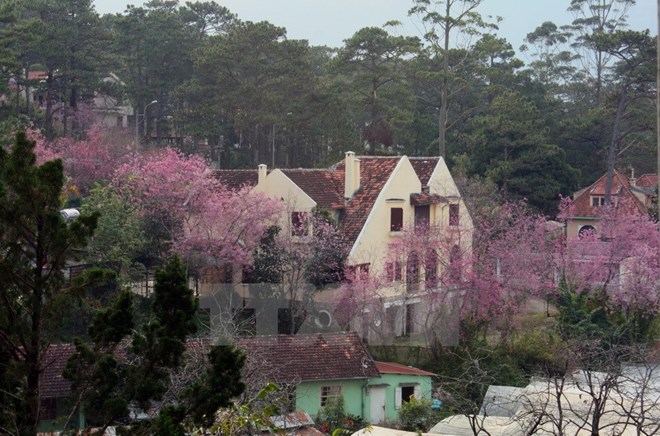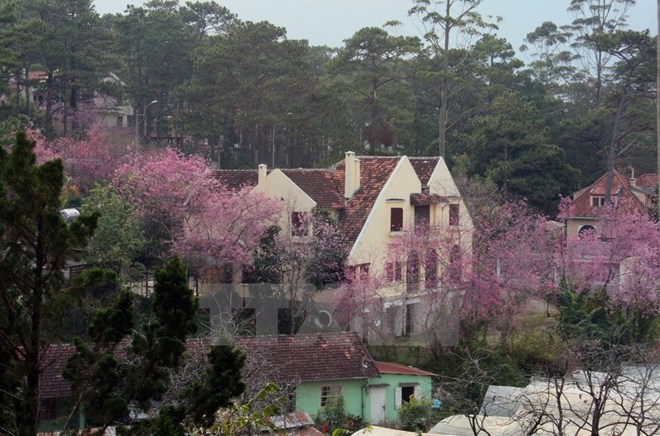
A cherry blossom festival will return to Tuyen Lam Lake in Da Lat city of the Central Highlands province of Lam Dong from January 26-28.

Da Lat is home to a cherry-like
apricot – Mai Anh Dao – known as the city’s floral emblem (Photo: VNA)
A ceremony will be held at Sacom Resort on the peninsula of the Tuyen Lam Lake
at 8:30 am on January 27 to kick off the festival and to announce the
recognition of Tuyen Lam National Resort and Da Lat city as ASEAN
Environmentally Sustainable City.
A variety of event will take place not only at the Tuyen Lam National Resort
but across the city during the three-day festival, including art performances,
musical fountain shows, a golf tournament, a Gong music night and an exhibition
of classic cars.
The festival aims to promote a local cherry-like apricot – Mai Anh Dao – known
as the city’s floral emblem. The flower blooms in pink in the first months of
the year to welcome the spring. The trees mostly grow in Da Lat city and
forests in Lac Duong district.
"I have never seen cherry blossom as beautiful as this year. The flowers
started to bloom at the beginning of January and in such a cool weather, they
will last until early February,” said Nguyen Xuan Thanh, Director of the Tuyen
Lam National Resort and head of the festival organising board.
Da Lat won the ASEAN Environmentally Sustainable City at the ASEAN
Environmental Award in Brunei in July last year.
Source: VNA
With an increasingly vibrant and widespread emulation movement aimed at building cultured residential areas and cultured families, Yen Thuy District has been making steady progress toward improving both the material and spiritual well-being of its people, while fostering a civilized, prosperous, beautiful, and progressive community.
Once lacking recreational spaces and community facilities, Residential Group 2 in Quynh Lam Ward (Hoa Binh City) has recently received attention for the construction of a new, spacious, and fully equipped cultural house. The project followed the model of state support combined with public contributions in both labor and funding.
The "All people unite to build cultural life" movement, which has been effectively integrated with Kim Boi district’s socio-economic development goals, is fostering a lively spirit of emulation across local residential areas, hamlets, villages, public agencies, and enterprises. In addition, through the initiative, traditional cultural values are being preserved and promoted, while community solidarity and mutual support in poverty reduction and economic development are being strengthened.
A working delegation of the Hoa Binh provincial People’s Committee led by its Permanent Vice Chairman Nguyen Van Toan on June 11 inspected the progress of a project to build the Mo Muong Cultural Heritage Conservation Space linked to tourism services in Hop Phong commune, Cao Phong district.
Born and growing in the heroic land of Muong Dong, Dinh Thi Kieu Dung, a resident in Bo town of Kim Boi district, in her childhood was nurtured by the sweet lullabies of her grandmother and mother. These melodies deeply imprinted on her soul, becoming an inseparable part of her love for her ethnic group's culture. For over 20 years, this love for her hometown has driven Dung to research, collect, and pass down the cultural values of the Muong people to future generations.
In the final days of May, the Ethnic Art Troupe of Hoa Binh Province organized performances to serve the people in remote, mountainous, and particularly disadvantaged areas within the province. These were not just ordinary artistic shows, but they were the meaningful journeys aimed at spreading cultural values, enhancing the spiritual life of the people and contributing to the preservation of ethnic minority cultural identities.



